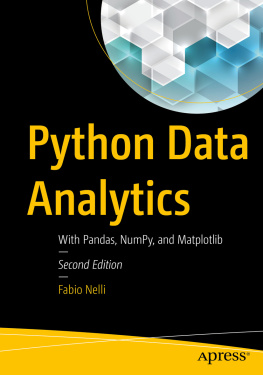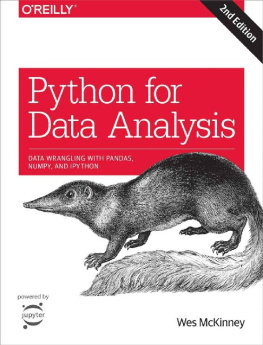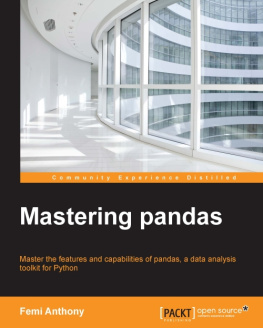McKinney - Python for data analysis : Data wrangling with Pandas, Numpy, and IPython
Here you can read online McKinney - Python for data analysis : Data wrangling with Pandas, Numpy, and IPython full text of the book (entire story) in english for free. Download pdf and epub, get meaning, cover and reviews about this ebook. City: Bejing, year: 2013, publisher: O’Reilly, genre: Computer. Description of the work, (preface) as well as reviews are available. Best literature library LitArk.com created for fans of good reading and offers a wide selection of genres:
Romance novel
Science fiction
Adventure
Detective
Science
History
Home and family
Prose
Art
Politics
Computer
Non-fiction
Religion
Business
Children
Humor
Choose a favorite category and find really read worthwhile books. Enjoy immersion in the world of imagination, feel the emotions of the characters or learn something new for yourself, make an fascinating discovery.
Python for data analysis : Data wrangling with Pandas, Numpy, and IPython: summary, description and annotation
We offer to read an annotation, description, summary or preface (depends on what the author of the book "Python for data analysis : Data wrangling with Pandas, Numpy, and IPython" wrote himself). If you haven't found the necessary information about the book — write in the comments, we will try to find it.
Python for data analysis : Data wrangling with Pandas, Numpy, and IPython — read online for free the complete book (whole text) full work
Below is the text of the book, divided by pages. System saving the place of the last page read, allows you to conveniently read the book "Python for data analysis : Data wrangling with Pandas, Numpy, and IPython" online for free, without having to search again every time where you left off. Put a bookmark, and you can go to the page where you finished reading at any time.
Font size:
Interval:
Bookmark:

Beijing Cambridge Farnham Kln Sebastopol Tokyo
If you purchased this ebook directly from oreilly.com, you have the following benefits:
DRM-free ebooksuse your ebooks across devices without restrictions or limitations
Multiple formatsuse on your laptop, tablet, or phone
Lifetime access, with free updates
Dropbox syncingyour files, anywhere
If you purchased this ebook from another retailer, you can upgrade your ebook to take advantage of all these benefits for just $4.99. to access your ebook upgrade.
Please note that upgrade offers are not available from sample content.
The scientific Python ecosystem of open source libraries has grown substantially over the last 10 years. By late 2011, I had long felt that the lack of centralized learning resources for data analysis and statistical applications was a stumbling block for new Python programmers engaged in such work. Key projects for data analysis (especially NumPy, IPython, matplotlib, and pandas) had also matured enough that a book written about them would likely not go out-of-date very quickly. Thus, I mustered the nerve to embark on this writing project. This is the book that I wish existed when I started using Python for data analysis in 2007. I hope you find it useful and are able to apply these tools productively in your work.
The following typographical conventions are used in this book:
Indicates new terms, URLs, email addresses, filenames, and file extensions.
Constant widthUsed for program listings, as well as within paragraphs to refer to program elements such as variable or function names, databases, data types, environment variables, statements, and keywords.
Constant width boldShows commands or other text that should be typed literally by the user.
Constant width italicShows text that should be replaced with user-supplied values or by values determined by context.
This icon signifies a tip, suggestion, or general note.
This icon indicates a warning or caution.
This book is here to help you get your job done. In general, you may use the code in this book in your programs and documentation. You do not need to contact us for permission unless youre reproducing a significant portion of the code. For example, writing a program that uses several chunks of code from this book does not require permission. Selling or distributing a CD-ROM of examples from OReilly books does require permission. Answering a question by citing this book and quoting example code does not require permission. Incorporating a significant amount of example code from this book into your products documentation does require permission.
We appreciate, but do not require, attribution. An attribution usually includes the title, author, publisher, and ISBN. For example: Python for Data Analysis by William Wesley McKinney (OReilly). Copyright 2012 William McKinney, 978-1-449-31979-3.
If you feel your use of code examples falls outside fair use or the permission given above, feel free to contact us at .
Safari Books Online (www.safaribooksonline.com) is an on-demand digital library that delivers expert content in both book and video form from the worlds leading authors in technology and business.
Technology professionals, software developers, web designers, and business and creative professionals use Safari Books Online as their primary resource for research, problem solving, learning, and certification training.
Safari Books Online offers a range of product mixes and pricing programs for organizations, government agencies, and individuals. Subscribers have access to thousands of books, training videos, and prepublication manuscripts in one fully searchable database from publishers like OReilly Media, Prentice Hall Professional, Addison-Wesley Professional, Microsoft Press, Sams, Que, Peachpit Press, Focal Press, Cisco Press, John Wiley & Sons, Syngress, Morgan Kaufmann, IBM Redbooks, Packt, Adobe Press, FT Press, Apress, Manning, New Riders, McGraw-Hill, Jones & Bartlett, Course Technology, and dozens more. For more information about Safari Books Online, please visit us online.
Please address comments and questions concerning this book to the publisher:
| OReilly Media, Inc. |
| 1005 Gravenstein Highway North |
| Sebastopol, CA 95472 |
| 800-998-9938 (in the United States or Canada) |
| 707-829-0515 (international or local) |
| 707-829-0104 (fax) |
We have a web page for this book, where we list errata, examples, and any additional information. You can access this page at http://oreil.ly/python_for_data_analysis.
To comment or ask technical questions about this book, send email to .
For more information about our books, courses, conferences, and news, see our website at http://www.oreilly.com.
Find us on Facebook: http://facebook.com/oreilly
Follow us on Twitter: http://twitter.com/oreillymedia
Watch us on YouTube: http://www.youtube.com/oreillymedia
This book is concerned with the nuts and bolts of manipulating, processing, cleaning, and crunching data in Python. It is also a practical, modern introduction to scientific computing in Python, tailored for data-intensive applications. This is a book about the parts of the Python language and libraries youll need to effectively solve a broad set of data analysis problems. This book is not an exposition on analytical methods using Python as the implementation language.
When I say data, what am I referring to exactly? The primary focus is on structured data , a deliberately vague term that encompasses many different common forms of data, such as
Multidimensional arrays (matrices)
Tabular or spreadsheet-like data in which each column may be a different type (string, numeric, date, or otherwise). This includes most kinds of data commonly stored in relational databases or tab- or comma-delimited text files
Multiple tables of data interrelated by key columns (what would be primary or foreign keys for a SQL user)
Evenly or unevenly spaced time series
This is by no means a complete list. Even though it may not always be obvious, a large percentage of data sets can be transformed into a structured form that is more suitable for analysis and modeling. If not, it may be possible to extract features from a data set into a structured form. As an example, a collection of news articles could be processed into a word frequency table which could then be used to perform sentiment analysis.
Most users of spreadsheet programs like Microsoft Excel, perhaps the most widely used data analysis tool in the world, will not be strangers to these kinds of data.
For many people (myself among them), the Python language is easy to fall in love with. Since its first appearance in 1991, Python has become one of the most popular dynamic, programming languages, along with Perl, Ruby, and others. Python and Ruby have become especially popular in recent years for building websites using their numerous web frameworks, like Rails (Ruby) and Django (Python). Such languages are often called
Font size:
Interval:
Bookmark:
Similar books «Python for data analysis : Data wrangling with Pandas, Numpy, and IPython»
Look at similar books to Python for data analysis : Data wrangling with Pandas, Numpy, and IPython. We have selected literature similar in name and meaning in the hope of providing readers with more options to find new, interesting, not yet read works.
Discussion, reviews of the book Python for data analysis : Data wrangling with Pandas, Numpy, and IPython and just readers' own opinions. Leave your comments, write what you think about the work, its meaning or the main characters. Specify what exactly you liked and what you didn't like, and why you think so.

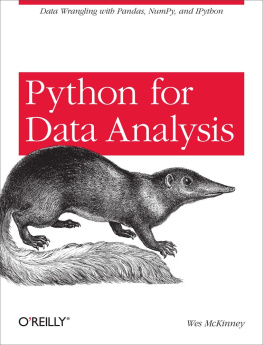




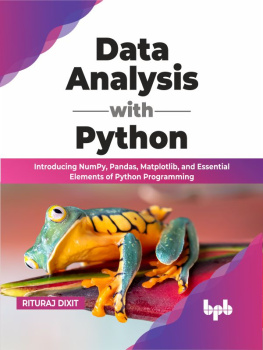
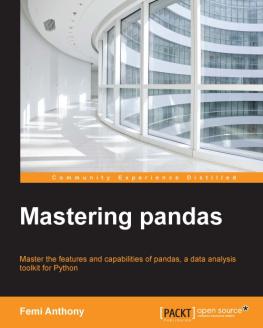
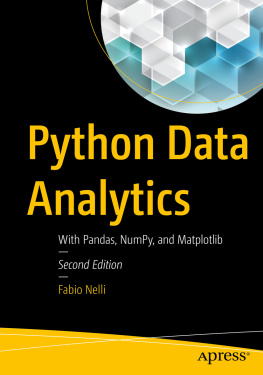
![Curtis Miller [Curtis Miller] - Hands-On Data Analysis with NumPy and pandas](/uploads/posts/book/119333/thumbs/curtis-miller-curtis-miller-hands-on-data.jpg)
